This page was built from the example_notebook Jupyter notebook available on Github
How to use¶
These pages will outline basic usage of DefDAP, including loading a DIC and EBSD map, linking them with homologous points and producing maps
Load in packages¶
DefDAP is split into modules for processing EBSD (defdap.ebsd) and HRDIC (defdap.hrdic) data. There are also modules for manpulating orientations (defdap.quat) and creating custom figures (defdap.plotting) which is introduced later. We also import some of the usual suspects of the python scientific stack: numpy and matplotlib.
[1]:
import numpy as np
import matplotlib.pyplot as plt
import defdap.hrdic as hrdic
import defdap.ebsd as ebsd
from defdap.quat import Quat
# try tk, qt, osx (if using mac) or notebook for interactive plots. If none work, use inline
%matplotlib inline
%cd -q ../
/home/docs/checkouts/readthedocs.org/user_builds/defdap/envs/latest/lib/python3.10/site-packages/IPython/core/magics/osm.py:417: UserWarning: using dhist requires you to install the `pickleshare` library.
self.shell.db['dhist'] = compress_dhist(dhist)[-100:]
Load in a HRDIC map¶
[2]:
dicFilePath = "../tests/data/"
dicMap = hrdic.Map(dicFilePath, "testDataDIC.txt")
Starting loading HRDIC data.. Loaded DaVis 8.4.0 data (dimensions: 300 x 200 pixels, sub-window size: 12 x 12 pixels)
</pre>
Starting loading HRDIC data.. Loaded DaVis 8.4.0 data (dimensions: 300 x 200 pixels, sub-window size: 12 x 12 pixels)
end{sphinxVerbatim}
Starting loading HRDIC data.. Loaded DaVis 8.4.0 data (dimensions: 300 x 200 pixels, sub-window size: 12 x 12 pixels)
Set the scale of the map¶
This is defined as the pixel size in the DIC pattern images, measured in microns per pixel.
[3]:
fieldWidth = 20 # microns
numPixels = 2048
pixelSize = fieldWidth / numPixels
dicMap.setScale(pixelSize)
Plot the map with a scale bar¶
[4]:
dicMap.plotMaxShear(vmin=0, vmax=0.10, plotScaleBar=True)
[4]:
<defdap.plotting.MapPlot at 0x7f859b20e290>
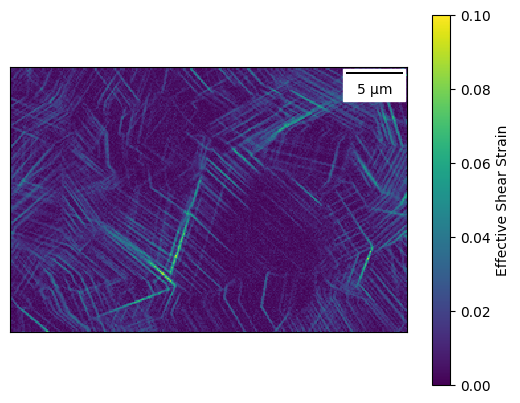
Crop the map¶
HRDIC maps often contain spurious data at the edges which should be removed before performing any analysis. The crop is defined by the number of points to remove from each edge of the map, where xMin, xMax, yMin and yMax are the left, right, top and bottom edges respectively. Note that the test data doesn not require cropping as it is a subset of a larger dataset.
[5]:
dicMap.setCrop(xMin=0, xMax=0, yMin=0, yMax=0)
Statistics¶
Some simple statistics such as the minimum, mean and maximum of the effective shear strain, E11 and E22 components can be printed.
[6]:
dicMap.printStatsTable(percentiles=[0, 50, 100], components = ['eMaxShear', 'e11', 'e22', 'e12'])
dicMap (dimensions: 300 x 200 pixels, sub-window size: 12 x 12 pixels, number of points: 60000)
Component 0 50 100
eMaxShear 0.0000 0.0085 0.0910
e11 -0.1083 -0.0097 0.0168
e22 -0.0493 0.0045 0.0850
e12 -0.0478 0.0005 0.0630
Set the location of the DIC pattern images¶
The pattern images are used later to define the position of homologous material points. The path is relative to the directory set when loading in the map. The second parameter is the pixel binning factor of the image relative to the DIC sub-region size i.e. the number of pixels in the image across a single datapoint in the DIC map. We recommend binning the pattern images by the same factor as the DIC sub-region size, doing so enhances the contrast between microstructure features.
[7]:
# set the path of the pattern image, this is relative to the location of the DIC data file
dicMap.setPatternPath("testDataPat.bmp", 1)
Load in an EBSD map¶
The crystal structure of each phase is read from file and used to set the slip systems for the phase. The orientation in the EBSD are converted to a quaternion representation so calculations can be applied later.
[8]:
ebsdFilePath = "../tests/data/testDataEBSD"
ebsdMap = ebsd.Map(ebsdFilePath)
ebsdMap.buildQuatArray()
Starting loading EBSD data.. Loaded EBSD data (dimensions: 359 x 243 pixels, step size: 0.12 um)
- Starting building quaternion array..
</pre>
Starting loading EBSD data.. Loaded EBSD data (dimensions: 359 x 243 pixels, step size: 0.12 um)
- Starting building quaternion array..
end{sphinxVerbatim}
Starting loading EBSD data.. Loaded EBSD data (dimensions: 359 x 243 pixels, step size: 0.12 um)
Starting building quaternion array..
Starting building quaternion array.. 100 % Finished building quaternion array (0:00:00)
</pre>
Starting building quaternion array.. 100 % Finished building quaternion array (0:00:00)
end{sphinxVerbatim}
Starting building quaternion array.. 100 % Finished building quaternion array (0:00:00)
Plot the EBSD map¶
Using an Euler colour mapping or inverse pole figure colouring with the sample reference direction passed as a vector.
[9]:
ebsdMap.plotEulerMap(plotScaleBar=True)
[9]:
<defdap.plotting.MapPlot at 0x7f859ab5bf70>

[10]:
ebsdMap.plotIPFMap([1,0,0], plotScaleBar=True)
[10]:
<defdap.plotting.MapPlot at 0x7f8591e8ba90>
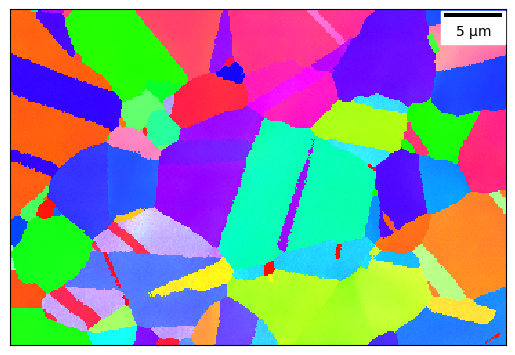
A KAM map can also be plotted as follows
[11]:
ebsdMap.plotKamMap(vmin=0, vmax=1)
[11]:
<defdap.plotting.MapPlot at 0x7f859aa05c30>
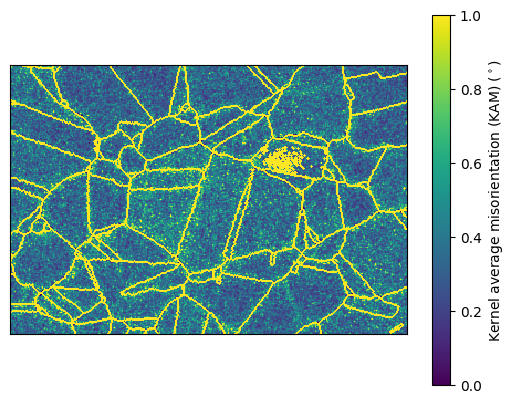
Detect grains in the EBSD¶
This is done in two stages: first bounaries are detected in the map as any point with a misorientation to a neighbouring point greater than a critical value (boundDef in degrees). A flood fill type algorithm is then applied to segment the map into grains, with any grains containining fewer than a critical number of pixels removed (minGrainSize in pixels). The data e.g. orientations associated with each grain are then stored (referenced strictly, the data isn’t stored twice) in a grain
object and a list of the grains is stored in the EBSD map (named grainList). This allows analysis routines to be applied to each grain in a map in turn.
[12]:
ebsdMap.findBoundaries(boundDef=8)
ebsdMap.findGrains(minGrainSize=10)
- Starting finding grain boundaries..
</pre>
- Starting finding grain boundaries..
end{sphinxVerbatim}
Starting finding grain boundaries..
Starting finding grain boundaries.. 100 % Finished finding grain boundaries (0:00:00)
- Starting finding grains..
</pre>
Starting finding grain boundaries.. 100 % Finished finding grain boundaries (0:00:00)
- Starting finding grains..
end{sphinxVerbatim}
Starting finding grain boundaries.. 100 % Finished finding grain boundaries (0:00:00)
Starting finding grains..
Starting finding grains.. 86 % Finished finding grains (0:00:00)
</pre>
Starting finding grains.. 86 % Finished finding grains (0:00:00)
end{sphinxVerbatim}
Starting finding grains.. 86 % Finished finding grains (0:00:00)
A list of the slip planes, colours and slip directions can be printed for each phase in the map.
[13]:
phase = ebsdMap.phases[0]
print(phase.name)
phase.printSlipSystems()
Ni-superalloy
Plane 0: (111) Colour: blue
Direction 0: [011̅]
Direction 1: [1̅01]
Direction 2: [11̅0]
Plane 1: (111̅) Colour: green
Direction 0: [011]
Direction 1: [1̅01̅]
Direction 2: [11̅0]
Plane 2: (1̅11) Colour: red
Direction 0: [011̅]
Direction 1: [101]
Direction 2: [1̅1̅0]
Plane 3: (11̅1) Colour: white
Direction 0: [01̅1̅]
Direction 1: [1̅01]
Direction 2: [110]
The Schmid factors for each grain can be calculated and plotted. The slipSystems argument can be specified, to only calculate the Schmid factor for certain planes, otherwise the maximum for all slip systems is calculated.
[14]:
ebsdMap.calcAverageGrainSchmidFactors(loadVector=np.array([1,0,0]), slipSystems=None)
Starting calculating grain average Schmid factors.. Starting calculating grain average Schmid factors.. 2 % Starting calculating grain average Schmid factors.. 4 %
</pre>
Starting calculating grain average Schmid factors.. Starting calculating grain average Schmid factors.. 2 % Starting calculating grain average Schmid factors.. 4 %
end{sphinxVerbatim}
Starting calculating grain average Schmid factors.. Starting calculating grain average Schmid factors.. 2 % Starting calculating grain average Schmid factors.. 4 %
Starting calculating grain average Schmid factors.. 6 % Starting calculating grain average Schmid factors.. 8 % Starting calculating grain average Schmid factors.. 9 %
</pre>
Starting calculating grain average Schmid factors.. 6 % Starting calculating grain average Schmid factors.. 8 % Starting calculating grain average Schmid factors.. 9 %
end{sphinxVerbatim}
Starting calculating grain average Schmid factors.. 6 % Starting calculating grain average Schmid factors.. 8 % Starting calculating grain average Schmid factors.. 9 %
Starting calculating grain average Schmid factors.. 11 % Starting calculating grain average Schmid factors.. 13 % Starting calculating grain average Schmid factors.. 15 %
</pre>
Starting calculating grain average Schmid factors.. 11 % Starting calculating grain average Schmid factors.. 13 % Starting calculating grain average Schmid factors.. 15 %
end{sphinxVerbatim}
Starting calculating grain average Schmid factors.. 11 % Starting calculating grain average Schmid factors.. 13 % Starting calculating grain average Schmid factors.. 15 %
Starting calculating grain average Schmid factors.. 17 % Starting calculating grain average Schmid factors.. 19 % Starting calculating grain average Schmid factors.. 21 % Starting calculating grain average Schmid factors.. 23 % Starting calculating grain average Schmid factors.. 25 %
</pre>
Starting calculating grain average Schmid factors.. 17 % Starting calculating grain average Schmid factors.. 19 % Starting calculating grain average Schmid factors.. 21 % Starting calculating grain average Schmid factors.. 23 % Starting calculating grain average Schmid factors.. 25 %
end{sphinxVerbatim}
Starting calculating grain average Schmid factors.. 17 % Starting calculating grain average Schmid factors.. 19 % Starting calculating grain average Schmid factors.. 21 % Starting calculating grain average Schmid factors.. 23 % Starting calculating grain average Schmid factors.. 25 %
Starting calculating grain average Schmid factors.. 26 % Starting calculating grain average Schmid factors.. 28 %
</pre>
Starting calculating grain average Schmid factors.. 26 % Starting calculating grain average Schmid factors.. 28 %
end{sphinxVerbatim}
Starting calculating grain average Schmid factors.. 26 % Starting calculating grain average Schmid factors.. 28 %
Starting calculating grain average Schmid factors.. 30 % Starting calculating grain average Schmid factors.. 32 %
</pre>
Starting calculating grain average Schmid factors.. 30 % Starting calculating grain average Schmid factors.. 32 %
end{sphinxVerbatim}
Starting calculating grain average Schmid factors.. 30 % Starting calculating grain average Schmid factors.. 32 %
Starting calculating grain average Schmid factors.. 34 % Starting calculating grain average Schmid factors.. 36 % Starting calculating grain average Schmid factors.. 38 % Starting calculating grain average Schmid factors.. 40 %
</pre>
Starting calculating grain average Schmid factors.. 34 % Starting calculating grain average Schmid factors.. 36 % Starting calculating grain average Schmid factors.. 38 % Starting calculating grain average Schmid factors.. 40 %
end{sphinxVerbatim}
Starting calculating grain average Schmid factors.. 34 % Starting calculating grain average Schmid factors.. 36 % Starting calculating grain average Schmid factors.. 38 % Starting calculating grain average Schmid factors.. 40 %
Starting calculating grain average Schmid factors.. 42 % Starting calculating grain average Schmid factors.. 43 % Starting calculating grain average Schmid factors.. 45 % Starting calculating grain average Schmid factors.. 47 %
</pre>
Starting calculating grain average Schmid factors.. 42 % Starting calculating grain average Schmid factors.. 43 % Starting calculating grain average Schmid factors.. 45 % Starting calculating grain average Schmid factors.. 47 %
end{sphinxVerbatim}
Starting calculating grain average Schmid factors.. 42 % Starting calculating grain average Schmid factors.. 43 % Starting calculating grain average Schmid factors.. 45 % Starting calculating grain average Schmid factors.. 47 %
Starting calculating grain average Schmid factors.. 49 % Starting calculating grain average Schmid factors.. 51 % Starting calculating grain average Schmid factors.. 53 % Starting calculating grain average Schmid factors.. 55 % Starting calculating grain average Schmid factors.. 57 %
</pre>
Starting calculating grain average Schmid factors.. 49 % Starting calculating grain average Schmid factors.. 51 % Starting calculating grain average Schmid factors.. 53 % Starting calculating grain average Schmid factors.. 55 % Starting calculating grain average Schmid factors.. 57 %
end{sphinxVerbatim}
Starting calculating grain average Schmid factors.. 49 % Starting calculating grain average Schmid factors.. 51 % Starting calculating grain average Schmid factors.. 53 % Starting calculating grain average Schmid factors.. 55 % Starting calculating grain average Schmid factors.. 57 %
Starting calculating grain average Schmid factors.. 58 % Starting calculating grain average Schmid factors.. 60 % Starting calculating grain average Schmid factors.. 62 % Starting calculating grain average Schmid factors.. 64 % Starting calculating grain average Schmid factors.. 66 % Starting calculating grain average Schmid factors.. 68 %
</pre>
Starting calculating grain average Schmid factors.. 58 % Starting calculating grain average Schmid factors.. 60 % Starting calculating grain average Schmid factors.. 62 % Starting calculating grain average Schmid factors.. 64 % Starting calculating grain average Schmid factors.. 66 % Starting calculating grain average Schmid factors.. 68 %
end{sphinxVerbatim}
Starting calculating grain average Schmid factors.. 58 % Starting calculating grain average Schmid factors.. 60 % Starting calculating grain average Schmid factors.. 62 % Starting calculating grain average Schmid factors.. 64 % Starting calculating grain average Schmid factors.. 66 % Starting calculating grain average Schmid factors.. 68 %
- Starting calculating grain average Schmid factors.. 70 %
</pre>
- Starting calculating grain average Schmid factors.. 70 %
end{sphinxVerbatim}
Starting calculating grain average Schmid factors.. 70 %
Starting calculating grain average Schmid factors.. 72 % Starting calculating grain average Schmid factors.. 74 % Starting calculating grain average Schmid factors.. 75 % Starting calculating grain average Schmid factors.. 77 % Starting calculating grain average Schmid factors.. 79 % Starting calculating grain average Schmid factors.. 81 % Starting calculating grain average Schmid factors.. 83 % Starting calculating grain average Schmid factors.. 85 % Starting calculating grain average Schmid factors.. 87 %
</pre>
Starting calculating grain average Schmid factors.. 72 % Starting calculating grain average Schmid factors.. 74 % Starting calculating grain average Schmid factors.. 75 % Starting calculating grain average Schmid factors.. 77 % Starting calculating grain average Schmid factors.. 79 % Starting calculating grain average Schmid factors.. 81 % Starting calculating grain average Schmid factors.. 83 % Starting calculating grain average Schmid factors.. 85 % Starting calculating grain average Schmid factors.. 87 %
end{sphinxVerbatim}
Starting calculating grain average Schmid factors.. 72 % Starting calculating grain average Schmid factors.. 74 % Starting calculating grain average Schmid factors.. 75 % Starting calculating grain average Schmid factors.. 77 % Starting calculating grain average Schmid factors.. 79 % Starting calculating grain average Schmid factors.. 81 % Starting calculating grain average Schmid factors.. 83 % Starting calculating grain average Schmid factors.. 85 % Starting calculating grain average Schmid factors.. 87 %
Starting calculating grain average Schmid factors.. 89 % Starting calculating grain average Schmid factors.. 91 % Starting calculating grain average Schmid factors.. 92 %
</pre>
Starting calculating grain average Schmid factors.. 89 % Starting calculating grain average Schmid factors.. 91 % Starting calculating grain average Schmid factors.. 92 %
end{sphinxVerbatim}
Starting calculating grain average Schmid factors.. 89 % Starting calculating grain average Schmid factors.. 91 % Starting calculating grain average Schmid factors.. 92 %
Starting calculating grain average Schmid factors.. 94 % Starting calculating grain average Schmid factors.. 96 % Starting calculating grain average Schmid factors.. 98 % Starting calculating grain average Schmid factors.. 100 % Finished calculating grain average Schmid factors (0:00:01)
</pre>
Starting calculating grain average Schmid factors.. 94 % Starting calculating grain average Schmid factors.. 96 % Starting calculating grain average Schmid factors.. 98 % Starting calculating grain average Schmid factors.. 100 % Finished calculating grain average Schmid factors (0:00:01)
end{sphinxVerbatim}
Starting calculating grain average Schmid factors.. 94 % Starting calculating grain average Schmid factors.. 96 % Starting calculating grain average Schmid factors.. 98 % Starting calculating grain average Schmid factors.. 100 % Finished calculating grain average Schmid factors (0:00:01)
[15]:
ebsdMap.plotAverageGrainSchmidFactorsMap()
[15]:
<defdap.plotting.MapPlot at 0x7f8592c23310>
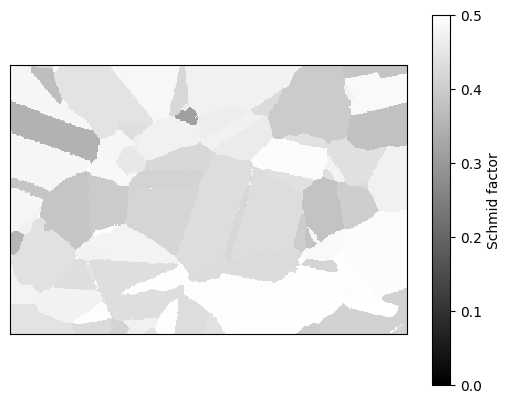
Single grain analysis¶
The locateGrainID method allows interactive selection of a grain of intereset to apply any analysis to. Clicking on grains in the map will highlight the grain and print out the grain ID (position in the grain list) of the grain.
[16]:
ebsdMap.locateGrainID()
[16]:
<defdap.plotting.MapPlot at 0x7f8592bf4610>
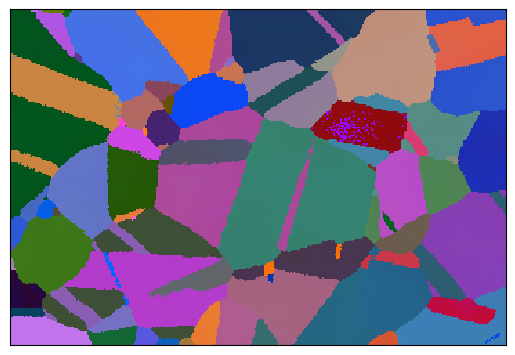
A built-in example is to calculate the average orientation of the grain and plot this orientation in a IPF
[17]:
grainID = 48
grain = ebsdMap[grainID]
grain.calcAverageOri() # stored as a quaternion named grain.refOri
print(grain.refOri)
grain.plotRefOri(direction=[0, 0, 1])
[0.3393, 0.1397, 0.4032, 0.8383]
[17]:
<defdap.plotting.PolePlot at 0x7f8592ca0b80>

The spread of orientations in a given grain can also be plotted on an IPF
[18]:
plot = grain.plotOriSpread(direction=np.array([0, 0, 1]), c='b', s=1, alpha=0.2)
grain.plotRefOri(direction=[0, 0, 1], c='k', plot=plot)
[18]:
<defdap.plotting.PolePlot at 0x7f8592bf6170>
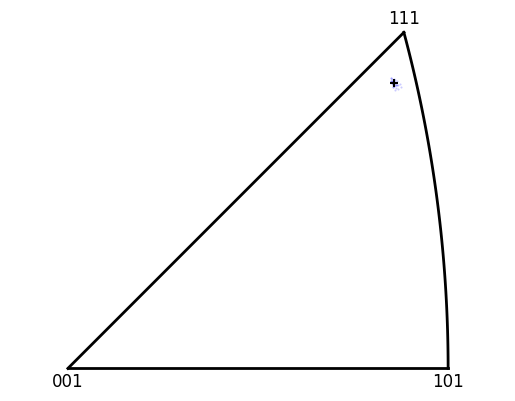
The unit cell for the average grain orientation can also be ploted
[19]:
grain.plotUnitCell()
[19]:
<defdap.plotting.CrystalPlot at 0x7f8591153b50>
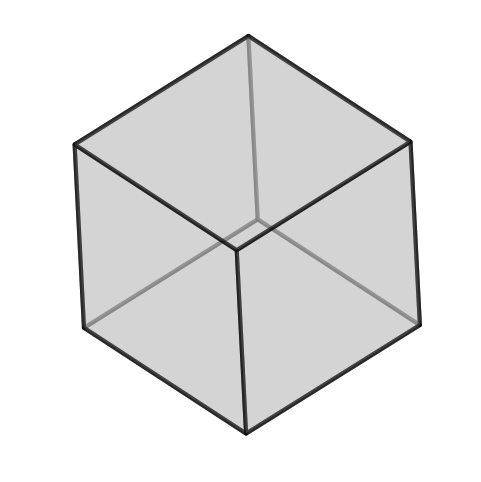
Printing a list of the slip plane indices, angle of slip plane intersection with the screen (defined as counter-clockwise from upwards), colour defined for the slip plane and also the slip directions and corresponding Schmid factors, is also built in
[20]:
grain.printSlipTraces()
(111) Colour: blue Angle: 55.77
[011̅] SF: 0.026
[1̅01] SF: 0.025
[11̅0] SF: 0.051
(111̅) Colour: green Angle: 89.67
[011] SF: 0.003
[1̅01̅] SF: 0.003
[11̅0] SF: 0.006
(1̅11) Colour: red Angle: 29.68
[011̅] SF: 0.404
[101] SF: 0.432
[1̅1̅0] SF: 0.027
(11̅1) Colour: white Angle: 152.39
[01̅1̅] SF: 0.381
[1̅01] SF: 0.410
[110] SF: 0.029
A second built-in example is to calcuate the grain misorientation, specifically the grain reference orientation deviation (GROD). This shows another feature of the locateGrainID method, which stores the ID of the last selected grain in a variable called currGrainId in the EBSD map.
[21]:
grain = ebsdMap[ebsdMap.currGrainId]
grain.buildMisOriList()
grain.plotMisOri(plotScaleBar=True, vmin=0, vmax=5)
---------------------------------------------------------------------------
TypeError Traceback (most recent call last)
Cell In[21], line 1
----> 1 grain = ebsdMap[ebsdMap.currGrainId]
2 grain.buildMisOriList()
3 grain.plotMisOri(plotScaleBar=True, vmin=0, vmax=5)
File ~/checkouts/readthedocs.org/user_builds/defdap/envs/latest/lib/python3.10/site-packages/defdap/base.py:63, in Map.__getitem__(self, key)
59 def __getitem__(self, key):
60 # Check that grains have been detected in the map
61 self.checkGrainsDetected()
---> 63 return self.grainList[key]
TypeError: list indices must be integers or slices, not NoneType
Multi grain analysis¶
Once an analysis routine has been prototyped for a single grain it can be applied to all the grains in a map using a loop over the grains and any results added to a list for use later. Of couse you could also apply to a smaller subset of grains as well.
[22]:
grainAvOris = []
for grain in ebsdMap:
grain.calcAverageOri()
grainAvOris.append(grain.refOri)
# Plot all the grain orientations in the map
Quat.plotIPF(grainAvOris, [0, 0, 1], ebsdMap.crystalSym, marker='o', s=10)
plt.tight_layout()
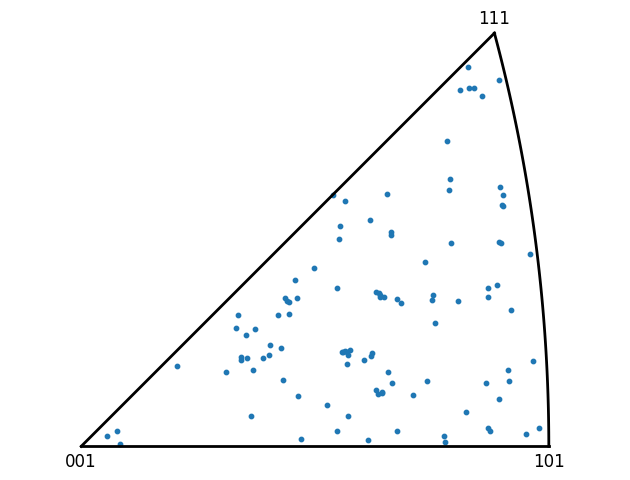
Some common grain analysis routines are built into the EBSD map object, including:
[23]:
ebsdMap.calcGrainAvOris()
Starting calculating grain mean orientations.. Starting calculating grain mean orientations.. 2 % Starting calculating grain mean orientations.. 4 % Starting calculating grain mean orientations.. 6 % Starting calculating grain mean orientations.. 8 %
</pre>
Starting calculating grain mean orientations.. Starting calculating grain mean orientations.. 2 % Starting calculating grain mean orientations.. 4 % Starting calculating grain mean orientations.. 6 % Starting calculating grain mean orientations.. 8 %
end{sphinxVerbatim}
Starting calculating grain mean orientations.. Starting calculating grain mean orientations.. 2 % Starting calculating grain mean orientations.. 4 % Starting calculating grain mean orientations.. 6 % Starting calculating grain mean orientations.. 8 %
Starting calculating grain mean orientations.. 9 % Starting calculating grain mean orientations.. 11 % Starting calculating grain mean orientations.. 13 % Starting calculating grain mean orientations.. 15 % Starting calculating grain mean orientations.. 17 % Starting calculating grain mean orientations.. 19 % Starting calculating grain mean orientations.. 21 %
</pre>
Starting calculating grain mean orientations.. 9 % Starting calculating grain mean orientations.. 11 % Starting calculating grain mean orientations.. 13 % Starting calculating grain mean orientations.. 15 % Starting calculating grain mean orientations.. 17 % Starting calculating grain mean orientations.. 19 % Starting calculating grain mean orientations.. 21 %
end{sphinxVerbatim}
Starting calculating grain mean orientations.. 9 % Starting calculating grain mean orientations.. 11 % Starting calculating grain mean orientations.. 13 % Starting calculating grain mean orientations.. 15 % Starting calculating grain mean orientations.. 17 % Starting calculating grain mean orientations.. 19 % Starting calculating grain mean orientations.. 21 %
Starting calculating grain mean orientations.. 23 % Starting calculating grain mean orientations.. 25 % Starting calculating grain mean orientations.. 26 % Starting calculating grain mean orientations.. 28 % Starting calculating grain mean orientations.. 30 % Starting calculating grain mean orientations.. 32 %
</pre>
Starting calculating grain mean orientations.. 23 % Starting calculating grain mean orientations.. 25 % Starting calculating grain mean orientations.. 26 % Starting calculating grain mean orientations.. 28 % Starting calculating grain mean orientations.. 30 % Starting calculating grain mean orientations.. 32 %
end{sphinxVerbatim}
Starting calculating grain mean orientations.. 23 % Starting calculating grain mean orientations.. 25 % Starting calculating grain mean orientations.. 26 % Starting calculating grain mean orientations.. 28 % Starting calculating grain mean orientations.. 30 % Starting calculating grain mean orientations.. 32 %
Starting calculating grain mean orientations.. 34 % Starting calculating grain mean orientations.. 36 % Starting calculating grain mean orientations.. 38 % Starting calculating grain mean orientations.. 40 % Starting calculating grain mean orientations.. 42 % Starting calculating grain mean orientations.. 43 % Starting calculating grain mean orientations.. 45 % Starting calculating grain mean orientations.. 47 %
</pre>
Starting calculating grain mean orientations.. 34 % Starting calculating grain mean orientations.. 36 % Starting calculating grain mean orientations.. 38 % Starting calculating grain mean orientations.. 40 % Starting calculating grain mean orientations.. 42 % Starting calculating grain mean orientations.. 43 % Starting calculating grain mean orientations.. 45 % Starting calculating grain mean orientations.. 47 %
end{sphinxVerbatim}
Starting calculating grain mean orientations.. 34 % Starting calculating grain mean orientations.. 36 % Starting calculating grain mean orientations.. 38 % Starting calculating grain mean orientations.. 40 % Starting calculating grain mean orientations.. 42 % Starting calculating grain mean orientations.. 43 % Starting calculating grain mean orientations.. 45 % Starting calculating grain mean orientations.. 47 %
Starting calculating grain mean orientations.. 49 % Starting calculating grain mean orientations.. 51 % Starting calculating grain mean orientations.. 53 % Starting calculating grain mean orientations.. 55 % Starting calculating grain mean orientations.. 57 % Starting calculating grain mean orientations.. 58 % Starting calculating grain mean orientations.. 60 % Starting calculating grain mean orientations.. 62 % Starting calculating grain mean orientations.. 64 % Starting calculating grain mean orientations.. 66 % Starting calculating grain mean orientations.. 68 %
</pre>
Starting calculating grain mean orientations.. 49 % Starting calculating grain mean orientations.. 51 % Starting calculating grain mean orientations.. 53 % Starting calculating grain mean orientations.. 55 % Starting calculating grain mean orientations.. 57 % Starting calculating grain mean orientations.. 58 % Starting calculating grain mean orientations.. 60 % Starting calculating grain mean orientations.. 62 % Starting calculating grain mean orientations.. 64 % Starting calculating grain mean orientations.. 66 % Starting calculating grain mean orientations.. 68 %
end{sphinxVerbatim}
Starting calculating grain mean orientations.. 49 % Starting calculating grain mean orientations.. 51 % Starting calculating grain mean orientations.. 53 % Starting calculating grain mean orientations.. 55 % Starting calculating grain mean orientations.. 57 % Starting calculating grain mean orientations.. 58 % Starting calculating grain mean orientations.. 60 % Starting calculating grain mean orientations.. 62 % Starting calculating grain mean orientations.. 64 % Starting calculating grain mean orientations.. 66 % Starting calculating grain mean orientations.. 68 %
Starting calculating grain mean orientations.. 70 % Starting calculating grain mean orientations.. 72 % Starting calculating grain mean orientations.. 74 % Starting calculating grain mean orientations.. 75 % Starting calculating grain mean orientations.. 77 % Starting calculating grain mean orientations.. 79 % Starting calculating grain mean orientations.. 81 % Starting calculating grain mean orientations.. 83 % Starting calculating grain mean orientations.. 85 % Starting calculating grain mean orientations.. 87 %
</pre>
Starting calculating grain mean orientations.. 70 % Starting calculating grain mean orientations.. 72 % Starting calculating grain mean orientations.. 74 % Starting calculating grain mean orientations.. 75 % Starting calculating grain mean orientations.. 77 % Starting calculating grain mean orientations.. 79 % Starting calculating grain mean orientations.. 81 % Starting calculating grain mean orientations.. 83 % Starting calculating grain mean orientations.. 85 % Starting calculating grain mean orientations.. 87 %
end{sphinxVerbatim}
Starting calculating grain mean orientations.. 70 % Starting calculating grain mean orientations.. 72 % Starting calculating grain mean orientations.. 74 % Starting calculating grain mean orientations.. 75 % Starting calculating grain mean orientations.. 77 % Starting calculating grain mean orientations.. 79 % Starting calculating grain mean orientations.. 81 % Starting calculating grain mean orientations.. 83 % Starting calculating grain mean orientations.. 85 % Starting calculating grain mean orientations.. 87 %
Starting calculating grain mean orientations.. 89 % Starting calculating grain mean orientations.. 91 % Starting calculating grain mean orientations.. 92 % Starting calculating grain mean orientations.. 94 % Starting calculating grain mean orientations.. 96 % Starting calculating grain mean orientations.. 98 % Starting calculating grain mean orientations.. 100 % Finished calculating grain mean orientations (0:00:01)
</pre>
Starting calculating grain mean orientations.. 89 % Starting calculating grain mean orientations.. 91 % Starting calculating grain mean orientations.. 92 % Starting calculating grain mean orientations.. 94 % Starting calculating grain mean orientations.. 96 % Starting calculating grain mean orientations.. 98 % Starting calculating grain mean orientations.. 100 % Finished calculating grain mean orientations (0:00:01)
end{sphinxVerbatim}
Starting calculating grain mean orientations.. 89 % Starting calculating grain mean orientations.. 91 % Starting calculating grain mean orientations.. 92 % Starting calculating grain mean orientations.. 94 % Starting calculating grain mean orientations.. 96 % Starting calculating grain mean orientations.. 98 % Starting calculating grain mean orientations.. 100 % Finished calculating grain mean orientations (0:00:01)
[24]:
ebsdMap.calcGrainMisOri()
ebsdMap.plotMisOriMap(vmin=0, vmax=5, plotGBs=True, plotScaleBar=True)
Starting calculating grain misorientations.. Starting calculating grain misorientations.. 2 % Starting calculating grain misorientations.. 4 % Starting calculating grain misorientations.. 6 % Starting calculating grain misorientations.. 8 % Starting calculating grain misorientations.. 9 % Starting calculating grain misorientations.. 11 % Starting calculating grain misorientations.. 13 % Starting calculating grain misorientations.. 15 % Starting calculating grain misorientations.. 17 % Starting calculating grain misorientations.. 19 % Starting calculating grain misorientations.. 21 %
</pre>
Starting calculating grain misorientations.. Starting calculating grain misorientations.. 2 % Starting calculating grain misorientations.. 4 % Starting calculating grain misorientations.. 6 % Starting calculating grain misorientations.. 8 % Starting calculating grain misorientations.. 9 % Starting calculating grain misorientations.. 11 % Starting calculating grain misorientations.. 13 % Starting calculating grain misorientations.. 15 % Starting calculating grain misorientations.. 17 % Starting calculating grain misorientations.. 19 % Starting calculating grain misorientations.. 21 %
end{sphinxVerbatim}
Starting calculating grain misorientations.. Starting calculating grain misorientations.. 2 % Starting calculating grain misorientations.. 4 % Starting calculating grain misorientations.. 6 % Starting calculating grain misorientations.. 8 % Starting calculating grain misorientations.. 9 % Starting calculating grain misorientations.. 11 % Starting calculating grain misorientations.. 13 % Starting calculating grain misorientations.. 15 % Starting calculating grain misorientations.. 17 % Starting calculating grain misorientations.. 19 % Starting calculating grain misorientations.. 21 %
Starting calculating grain misorientations.. 23 % Starting calculating grain misorientations.. 25 % Starting calculating grain misorientations.. 26 % Starting calculating grain misorientations.. 28 % Starting calculating grain misorientations.. 30 %
</pre>
Starting calculating grain misorientations.. 23 % Starting calculating grain misorientations.. 25 % Starting calculating grain misorientations.. 26 % Starting calculating grain misorientations.. 28 % Starting calculating grain misorientations.. 30 %
end{sphinxVerbatim}
Starting calculating grain misorientations.. 23 % Starting calculating grain misorientations.. 25 % Starting calculating grain misorientations.. 26 % Starting calculating grain misorientations.. 28 % Starting calculating grain misorientations.. 30 %
Starting calculating grain misorientations.. 32 % Starting calculating grain misorientations.. 34 % Starting calculating grain misorientations.. 36 % Starting calculating grain misorientations.. 38 % Starting calculating grain misorientations.. 40 % Starting calculating grain misorientations.. 42 % Starting calculating grain misorientations.. 43 % Starting calculating grain misorientations.. 45 % Starting calculating grain misorientations.. 47 % Starting calculating grain misorientations.. 49 % Starting calculating grain misorientations.. 51 % Starting calculating grain misorientations.. 53 % Starting calculating grain misorientations.. 55 %
</pre>
Starting calculating grain misorientations.. 32 % Starting calculating grain misorientations.. 34 % Starting calculating grain misorientations.. 36 % Starting calculating grain misorientations.. 38 % Starting calculating grain misorientations.. 40 % Starting calculating grain misorientations.. 42 % Starting calculating grain misorientations.. 43 % Starting calculating grain misorientations.. 45 % Starting calculating grain misorientations.. 47 % Starting calculating grain misorientations.. 49 % Starting calculating grain misorientations.. 51 % Starting calculating grain misorientations.. 53 % Starting calculating grain misorientations.. 55 %
end{sphinxVerbatim}
Starting calculating grain misorientations.. 32 % Starting calculating grain misorientations.. 34 % Starting calculating grain misorientations.. 36 % Starting calculating grain misorientations.. 38 % Starting calculating grain misorientations.. 40 % Starting calculating grain misorientations.. 42 % Starting calculating grain misorientations.. 43 % Starting calculating grain misorientations.. 45 % Starting calculating grain misorientations.. 47 % Starting calculating grain misorientations.. 49 % Starting calculating grain misorientations.. 51 % Starting calculating grain misorientations.. 53 % Starting calculating grain misorientations.. 55 %
Starting calculating grain misorientations.. 57 % Starting calculating grain misorientations.. 58 % Starting calculating grain misorientations.. 60 % Starting calculating grain misorientations.. 62 % Starting calculating grain misorientations.. 64 % Starting calculating grain misorientations.. 66 % Starting calculating grain misorientations.. 68 %
</pre>
Starting calculating grain misorientations.. 57 % Starting calculating grain misorientations.. 58 % Starting calculating grain misorientations.. 60 % Starting calculating grain misorientations.. 62 % Starting calculating grain misorientations.. 64 % Starting calculating grain misorientations.. 66 % Starting calculating grain misorientations.. 68 %
end{sphinxVerbatim}
Starting calculating grain misorientations.. 57 % Starting calculating grain misorientations.. 58 % Starting calculating grain misorientations.. 60 % Starting calculating grain misorientations.. 62 % Starting calculating grain misorientations.. 64 % Starting calculating grain misorientations.. 66 % Starting calculating grain misorientations.. 68 %
Starting calculating grain misorientations.. 70 % Starting calculating grain misorientations.. 72 % Starting calculating grain misorientations.. 74 % Starting calculating grain misorientations.. 75 % Starting calculating grain misorientations.. 77 % Starting calculating grain misorientations.. 79 % Starting calculating grain misorientations.. 81 % Starting calculating grain misorientations.. 83 % Starting calculating grain misorientations.. 85 % Starting calculating grain misorientations.. 87 % Starting calculating grain misorientations.. 89 % Starting calculating grain misorientations.. 91 % Starting calculating grain misorientations.. 92 % Starting calculating grain misorientations.. 94 % Starting calculating grain misorientations.. 96 % Starting calculating grain misorientations.. 98 % Starting calculating grain misorientations.. 100 % Finished calculating grain misorientations (0:00:00)
</pre>
Starting calculating grain misorientations.. 70 % Starting calculating grain misorientations.. 72 % Starting calculating grain misorientations.. 74 % Starting calculating grain misorientations.. 75 % Starting calculating grain misorientations.. 77 % Starting calculating grain misorientations.. 79 % Starting calculating grain misorientations.. 81 % Starting calculating grain misorientations.. 83 % Starting calculating grain misorientations.. 85 % Starting calculating grain misorientations.. 87 % Starting calculating grain misorientations.. 89 % Starting calculating grain misorientations.. 91 % Starting calculating grain misorientations.. 92 % Starting calculating grain misorientations.. 94 % Starting calculating grain misorientations.. 96 % Starting calculating grain misorientations.. 98 % Starting calculating grain misorientations.. 100 % Finished calculating grain misorientations (0:00:00)
end{sphinxVerbatim}
Starting calculating grain misorientations.. 70 % Starting calculating grain misorientations.. 72 % Starting calculating grain misorientations.. 74 % Starting calculating grain misorientations.. 75 % Starting calculating grain misorientations.. 77 % Starting calculating grain misorientations.. 79 % Starting calculating grain misorientations.. 81 % Starting calculating grain misorientations.. 83 % Starting calculating grain misorientations.. 85 % Starting calculating grain misorientations.. 87 % Starting calculating grain misorientations.. 89 % Starting calculating grain misorientations.. 91 % Starting calculating grain misorientations.. 92 % Starting calculating grain misorientations.. 94 % Starting calculating grain misorientations.. 96 % Starting calculating grain misorientations.. 98 % Starting calculating grain misorientations.. 100 % Finished calculating grain misorientations (0:00:00)
[24]:
<defdap.plotting.MapPlot at 0x7f8592bf56f0>

There are also methods for plotting GND density, phases and boundaries. All of the plotting functions in DefDAP use the same parameters to modify the plot, examples seen so far are plotGBs, plotScaleBar, vmin, vmax.
Linking the HRDIC and EBSD¶
Define homologous points¶
To register the two datasets, homologous points (points at the same material location) within each map are used to estimate a transformation between the two frames the data are defined in. The homologous points are selected manually using an interactive tool within DefDAP. To select homologous call the method setHomogPoint on each of the data maps, which will open a plot window with a button labelled ‘save point’ in the bottom right. You select a point by right clicking on the map, adjust
the position with the arrow and accept the point by with the save point button. Then select the same location in the other map. Note that as we set the location of the pattern image for the HRDIC map that the points can be selected on the pattern image rather than the strain data.
[25]:
dicMap.setHomogPoint(display="pattern")

[26]:
ebsdMap.setHomogPoint()
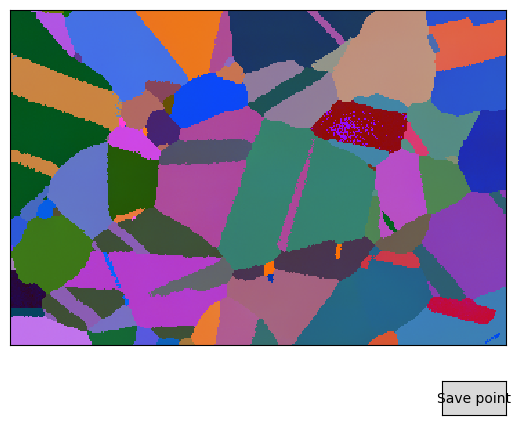
The points are stored as a list of tuples (x, y) in each of the maps. This means the points can be set from previous values.
[27]:
dicMap.homogPoints
[27]:
[]
[28]:
ebsdMap.homogPoints
[28]:
[]
Here are some example homologous points for this data, after setting these by running the cells below you can view the locations in the maps by running the setHomogPoint methods (above) again
[29]:
dicMap.homogPoints = [
(36, 72),
(279, 27),
(162, 174),
(60, 157)
]
[30]:
ebsdMap.homogPoints = [
(68, 95),
(308, 45),
(191, 187),
(89, 174)
]
Link the maps¶
Finally the two data maps are linked. The type of transform between the two frames can be affine, projective, polynomial.
[31]:
dicMap.linkEbsdMap(ebsdMap, transformType="affine")
# dicMap.linkEbsdMap(ebsdMap, transformType="projective")
# dicMap.linkEbsdMap(ebsdMap, transformType="polynomial", order=2)
Show the transformation¶
[32]:
from skimage import transform as tf
data = np.zeros((2000, 2000), dtype=float)
data[500:1500, 500:1500] = 1.
dataWarped = tf.warp(data, dicMap.ebsdTransform)
fig, (ax1, ax2) = plt.subplots(1, 2, figsize=(8,4))
ax1.set_title('Reference')
ax1.imshow(data)
ax2.set_title('Transformed')
ax2.imshow(dataWarped)
[32]:
<matplotlib.image.AxesImage at 0x7f8590776aa0>

Segment into grains¶
The HRDIC map can now be segmented into grains using the grain boundaries detected in the EBSD map. Analysis rountines can then be applied to individual grain, as with the EBSD grains. The grain finding process will also attempt to link the grains between the EBSD and HRDIC and each grain in the HRDIC has a reference (ebsdGrain) to the corrosponding grain in the EBSD map.
[33]:
dicMap.findGrains(minGrainSize=10)
- Starting finding grains..
</pre>
- Starting finding grains..
end{sphinxVerbatim}
Starting finding grains..
---------------------------------------------------------------------------
IndexError Traceback (most recent call last)
Cell In[33], line 1
----> 1 dicMap.findGrains(minGrainSize=10)
File ~/checkouts/readthedocs.org/user_builds/defdap/envs/latest/lib/python3.10/site-packages/defdap/utils.py:47, in reportProgress.<locals>.decorator.<locals>.wrapper(*args, **kwargs)
45 try:
46 while True:
---> 47 prog = next(generator)
48 if type(prog) is str:
49 printFinal = False
File ~/checkouts/readthedocs.org/user_builds/defdap/envs/latest/lib/python3.10/site-packages/defdap/hrdic.py:942, in Map.findGrains(self, algorithm, minGrainSize)
937 for i in range(len(self)):
938 # Find grain by masking the native ebsd grain image with
939 # selected grain from the warped dic grain image. The modal
940 # value is the EBSD grain label.
941 modeId, _ = mode(self.ebsdMap.grains[warpedDicGrains == i + 1])
--> 942 ebsd_grain_idx = modeId[0] - 1
943 self.ebsdGrainIds.append(ebsd_grain_idx)
944 self[i].ebsdGrainId = ebsd_grain_idx
IndexError: invalid index to scalar variable.
[34]:
dicMap.plotMaxShear(vmin=0, vmax=0.1, plotScaleBar=True, plotGBs=True)
[34]:
<defdap.plotting.MapPlot at 0x7f858fdff640>
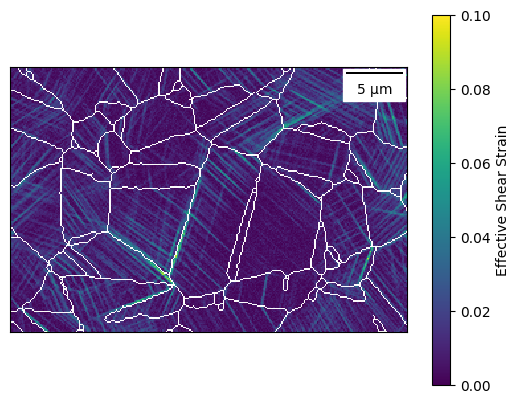
Now, a grain can also be selected interactively in the DIC map, in the same way a grain can be selected from an EBSD map. If displaySelected is set to true, then a pop-out window shows the map segmented for the grain
[35]:
dicMap.locateGrainID(displaySelected=True)
[35]:
<defdap.plotting.MapPlot at 0x7f859061dde0>
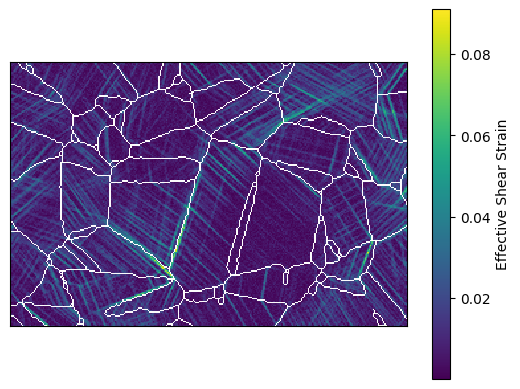
Plotting examples¶
Some of the plotting features are shown in examples below.
Built-in plots¶
[36]:
plot = dicMap.plotMaxShear(
vmin=0, vmax=0.1, plotScaleBar=True,
plotGBs=True, dilateBoundaries=True
)
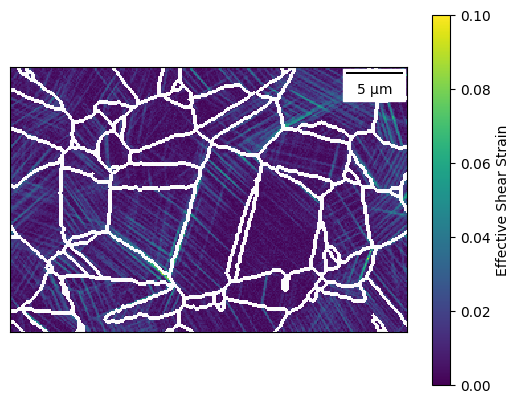
[37]:
plot = ebsdMap.plotEulerMap(
plotScaleBar=True, plotGBs=True,
highlightGrains=[10, 20, 45], highlightAlpha=0.9, highlightColours=['y']
)

[38]:
dicGrainID = 41
dicGrain = dicMap[dicGrainID]
plot = dicGrain.plotMaxShear(
plotScaleBar=True, plotSlipTraces=True, plotSlipBands=True
)
---------------------------------------------------------------------------
AttributeError Traceback (most recent call last)
Cell In[38], line 4
1 dicGrainID = 41
2 dicGrain = dicMap[dicGrainID]
----> 4 plot = dicGrain.plotMaxShear(
5 plotScaleBar=True, plotSlipTraces=True, plotSlipBands=True
6 )
File ~/checkouts/readthedocs.org/user_builds/defdap/envs/latest/lib/python3.10/site-packages/defdap/hrdic.py:1102, in Grain.plotMaxShear(self, **kwargs)
1096 plotParams = {
1097 'plotColourBar': True,
1098 'clabel': "Effective shear strain"
1099 }
1100 plotParams.update(kwargs)
-> 1102 plot = self.plotGrainData(grainData=self.maxShearList, **plotParams)
1104 return plot
File ~/checkouts/readthedocs.org/user_builds/defdap/envs/latest/lib/python3.10/site-packages/defdap/base.py:1056, in Grain.plotGrainData(self, mapData, grainData, **kwargs)
1052 plotParams.update(kwargs)
1054 grainMapData = self.grainMapData(mapData=mapData, grainData=grainData)
-> 1056 plot = GrainPlot.create(self, grainMapData, **plotParams)
1058 return plot
File ~/checkouts/readthedocs.org/user_builds/defdap/envs/latest/lib/python3.10/site-packages/defdap/plotting.py:954, in GrainPlot.create(cls, callingGrain, mapData, fig, figParams, ax, axParams, plot, makeInteractive, plotColourBar, vmin, vmax, cmap, clabel, plotScaleBar, scale, plotSlipTraces, plotSlipBands, **kwargs)
951 plot.addScaleBar(scale=scale)
953 if plotSlipTraces:
--> 954 plot.addSlipTraces()
956 if plotSlipBands:
957 plot.addSlipBands(grainMapData=mapData)
File ~/checkouts/readthedocs.org/user_builds/defdap/envs/latest/lib/python3.10/site-packages/defdap/plotting.py:848, in GrainPlot.addSlipTraces(self, topOnly, colours, pos, **kwargs)
832 """Add slip traces to plot, based on the calling grain's slip systems.
833
834 Parameters
(...)
844
845 """
847 if colours is None:
--> 848 colours = self.callingGrain.ebsdGrain.phase.slipTraceColours
849 slipTraceAngles = self.callingGrain.slipTraces
851 self.addTraces(slipTraceAngles, colours, topOnly, pos=pos, **kwargs)
AttributeError: 'NoneType' object has no attribute 'phase'
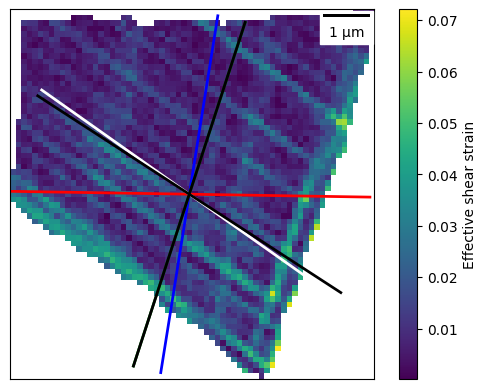
IPF plotting¶
This plot will show the positions of selected grains in an IPF pole figure, with the marker size representing grain area and mean effective shear strain.
[39]:
# For all grains in the DIC map
# Make an array of quaternions
grainOris = [grain.ebsdGrain.refOri for grain in dicMap]
# Make an array of grain area
grainAreas = np.array([len(grain) for grain in dicMap]) * dicMap.scale**2
# Scaling the grain area, so that the maximum size of a marker is 200 points^2
grainAreaScaling = 200. / grainAreas.max()
# Make an array of mean effective shear strain
grainStrains = [np.array(grain.maxShearList).mean() for grain in dicMap]
plot = Quat.plotIPF(grainOris, direction=[1,0,0], symGroup='cubic', marker='o',
s=grainAreas*grainAreaScaling, vmin=0, vmax=0.018, cmap='viridis', c=grainStrains)
plot.addColourBar(label='Mean Effective Shear Strain')
plot.addLegend(scaling=grainAreaScaling)
---------------------------------------------------------------------------
AttributeError Traceback (most recent call last)
Cell In[39], line 4
1 # For all grains in the DIC map
2
3 # Make an array of quaternions
----> 4 grainOris = [grain.ebsdGrain.refOri for grain in dicMap]
6 # Make an array of grain area
7 grainAreas = np.array([len(grain) for grain in dicMap]) * dicMap.scale**2
Cell In[39], line 4, in <listcomp>(.0)
1 # For all grains in the DIC map
2
3 # Make an array of quaternions
----> 4 grainOris = [grain.ebsdGrain.refOri for grain in dicMap]
6 # Make an array of grain area
7 grainAreas = np.array([len(grain) for grain in dicMap]) * dicMap.scale**2
AttributeError: 'NoneType' object has no attribute 'refOri'
[40]:
# For selected grains in the DIC map
# Select grains from the DIC map
dicGrainIDs = [2, 5, 7, 9, 15, 17, 18, 23, 29, 32, 33, 37, 40, 42, 49, 50, 51, 54, 58, 60]
# Make an array of quaternions
grainOris = np.array([dicMap[grainID].ebsdGrain.refOri for grainID in dicGrainIDs])
# Make an array of grain area
grainAreas = np.array([len(dicMap[grainID]) for grainID in dicGrainIDs]) * dicMap.scale**2
# Scaling the grain area, so that the maximum size of a marker is 200 points^2
grainAreaScaling = 200. / grainAreas.max()
# Make an array of mean effective shear strain
grainStrains = np.array([np.mean(dicMap[grain].maxShearList) for grain in dicGrainIDs])
plot = Quat.plotIPF(grainOris, direction=[1,0,0], symGroup='cubic', marker='o',
s=grainAreas*grainAreaScaling, vmin=0, vmax=0.018, cmap='viridis', c=grainStrains)
plot.addColourBar(label='Mean Effective Shear Strain')
plot.addLegend(scaling=grainAreaScaling)
---------------------------------------------------------------------------
AttributeError Traceback (most recent call last)
Cell In[40], line 7
4 dicGrainIDs = [2, 5, 7, 9, 15, 17, 18, 23, 29, 32, 33, 37, 40, 42, 49, 50, 51, 54, 58, 60]
6 # Make an array of quaternions
----> 7 grainOris = np.array([dicMap[grainID].ebsdGrain.refOri for grainID in dicGrainIDs])
9 # Make an array of grain area
10 grainAreas = np.array([len(dicMap[grainID]) for grainID in dicGrainIDs]) * dicMap.scale**2
Cell In[40], line 7, in <listcomp>(.0)
4 dicGrainIDs = [2, 5, 7, 9, 15, 17, 18, 23, 29, 32, 33, 37, 40, 42, 49, 50, 51, 54, 58, 60]
6 # Make an array of quaternions
----> 7 grainOris = np.array([dicMap[grainID].ebsdGrain.refOri for grainID in dicGrainIDs])
9 # Make an array of grain area
10 grainAreas = np.array([len(dicMap[grainID]) for grainID in dicGrainIDs]) * dicMap.scale**2
AttributeError: 'NoneType' object has no attribute 'refOri'
Create your own¶
[41]:
from defdap.plotting import MapPlot, GrainPlot, HistPlot
[42]:
mapData = dicMap.e11
mapData = dicMap.crop(mapData)
plot = MapPlot.create(
dicMap, mapData,
vmin=-0.1, vmax=0.1, plotColourBar=True, cmap="seismic",
plotGBs=True, dilateBoundaries=True, boundaryColour='black'
)
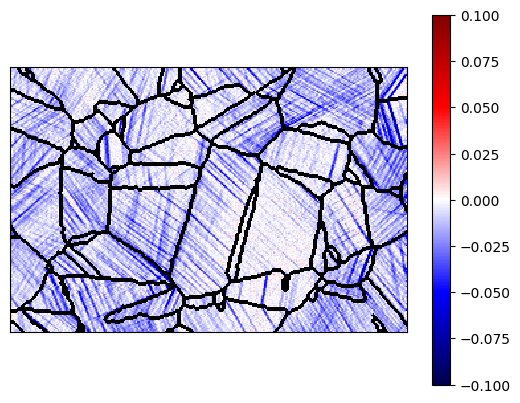
[43]:
plot.addScaleBar()
Functions for grain averaging and grain segmentation¶
[44]:
plot = dicMap.plotGrainDataMap(
mapData,
vmin=-0.06, vmax=0.06, plotColourBar=True,
cmap="seismic", clabel="Axial strain ($e_11$)",
plotScaleBar=True
)
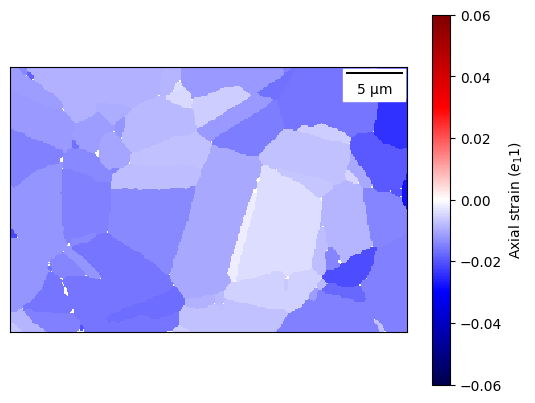
[45]:
plot.addGrainBoundaries(dilate=True, colour="white")
[45]:
<matplotlib.image.AxesImage at 0x7f858f8177c0>
[46]:
plot = dicMap.plotGrainDataIPF(
np.array((1,0,0)), mapData, marker='o',
vmin=-0.06, vmax=0.06, plotColourBar=True,
clabel="Axial strain ($e_11$)", cmap="seismic",
)
---------------------------------------------------------------------------
AttributeError Traceback (most recent call last)
Cell In[46], line 1
----> 1 plot = dicMap.plotGrainDataIPF(
2 np.array((1,0,0)), mapData, marker='o',
3 vmin=-0.06, vmax=0.06, plotColourBar=True,
4 clabel="Axial strain ($e_11$)", cmap="seismic",
5 )
File ~/checkouts/readthedocs.org/user_builds/defdap/envs/latest/lib/python3.10/site-packages/defdap/base.py:770, in Map.plotGrainDataIPF(self, direction, mapData, grainData, grainIds, **kwargs)
768 for i, grainId in enumerate(grainIds):
769 grain = self[grainId]
--> 770 grainOri[i] = grain.refOri
772 plot = Quat.plotIPF(grainOri, direction, self.crystalSym,
773 c=grainData, **plotParams)
775 return plot
File ~/checkouts/readthedocs.org/user_builds/defdap/envs/latest/lib/python3.10/site-packages/defdap/hrdic.py:1115, in Grain.refOri(self)
1106 @property
1107 def refOri(self):
1108 """Returns average grain orientation.
1109
1110 Returns
(...)
1113
1114 """
-> 1115 return self.ebsdGrain.refOri
AttributeError: 'NoneType' object has no attribute 'refOri'
[47]:
dicGrainID = 41
dicGrain = dicMap[dicGrainID]
plot = dicGrain.plotGrainData(
mapData,
vmin=-0.1, vmax=0.1, plotColourBar=True,
clabel="Axial strain ($e_11$)", cmap="seismic",
plotScaleBar=True
)

[48]:
plot.addSlipTraces()
---------------------------------------------------------------------------
AttributeError Traceback (most recent call last)
Cell In[48], line 1
----> 1 plot.addSlipTraces()
File ~/checkouts/readthedocs.org/user_builds/defdap/envs/latest/lib/python3.10/site-packages/defdap/plotting.py:848, in GrainPlot.addSlipTraces(self, topOnly, colours, pos, **kwargs)
832 """Add slip traces to plot, based on the calling grain's slip systems.
833
834 Parameters
(...)
844
845 """
847 if colours is None:
--> 848 colours = self.callingGrain.ebsdGrain.phase.slipTraceColours
849 slipTraceAngles = self.callingGrain.slipTraces
851 self.addTraces(slipTraceAngles, colours, topOnly, pos=pos, **kwargs)
AttributeError: 'NoneType' object has no attribute 'phase'
Composite plots¶
By utilising some additional functionality within matplotlib, composite plots can be produced.
[49]:
from matplotlib import gridspec
[50]:
# Create a figure with 3 sets of axes
fig = plt.figure(figsize=(8, 4))
gs = gridspec.GridSpec(2, 2, width_ratios=[3, 1],
wspace=0.15, hspace=0.15,
left=0.02, right=0.98,
bottom=0.12, top=0.95)
ax0 = plt.subplot(gs[:, 0])
ax1 = plt.subplot(gs[0, 1])
ax2 = plt.subplot(gs[1, 1])
# add a strain map
plot0 = dicMap.plotMaxShear(
ax=ax0, fig=fig,
vmin=0, vmax=0.08, plotScaleBar=True,
plotGBs=True, dilateBoundaries=True
)
# add an IPF of grain orientations
dicOris = []
for grain in dicMap:
if len(grain) > 20:
dicOris.append(grain.refOri)
plot1 = Quat.plotIPF(
dicOris, np.array((1,0,0)), 'cubic',
ax=ax1, fig=fig, s=10
)
# add histrogram of strain values
plot2 = HistPlot.create(
dicMap.crop(dicMap.eMaxShear),
ax=ax2, fig=fig, marker='o', markersize=2,
axesType="logy", bins=50, range=(0,0.06)
)
plot2.ax.set_xlabel("Effective shear strain")
---------------------------------------------------------------------------
AttributeError Traceback (most recent call last)
Cell In[50], line 23
21 for grain in dicMap:
22 if len(grain) > 20:
---> 23 dicOris.append(grain.refOri)
24 plot1 = Quat.plotIPF(
25 dicOris, np.array((1,0,0)), 'cubic',
26 ax=ax1, fig=fig, s=10
27 )
29 # add histrogram of strain values
File ~/checkouts/readthedocs.org/user_builds/defdap/envs/latest/lib/python3.10/site-packages/defdap/hrdic.py:1115, in Grain.refOri(self)
1106 @property
1107 def refOri(self):
1108 """Returns average grain orientation.
1109
1110 Returns
(...)
1113
1114 """
-> 1115 return self.ebsdGrain.refOri
AttributeError: 'NoneType' object has no attribute 'refOri'

Figures can be saved to raster (png, jpg, ..) and vector formats (eps, svg), the format is guessed from the file extension given. The last displayed figure can be saved using:
[51]:
plt.savefig("test_save_fig.png", dpi=200)
plt.savefig("test_save_fig.eps", dpi=200)
<Figure size 640x480 with 0 Axes>
[52]:
fig, ((ax0, ax1), (ax2, ax3)) = plt.subplots(2, 2, figsize=(8, 6))
dicGrainID = 41
dicGrain = dicMap[dicGrainID]
# add a strain map
plot0 = dicGrain.plotMaxShear(
ax=ax0, fig=fig,
vmin=0, vmax=0.08, plotScaleBar=True,
plotSlipTraces=True
)
# add a misorientation
ebsdGrain = dicGrain.ebsdGrain
plot1 = ebsdGrain.plotMisOri(component=0, ax=ax1, fig=fig, vmin=0, vmax=1, clabel="GROD", plotScaleBar=True)
# add an IPF
plot2 = ebsdGrain.plotOriSpread(
direction=np.array((1,0,0)), c='b', s=1, alpha=0.2,
ax=ax2, fig=fig
)
ebsdGrain.plotRefOri(
direction=np.array((1,0,0)), c='k', s=100, plot=plot2
)
# add histrogram of strain values
plot3 = HistPlot.create(
dicMap.crop(dicMap.eMaxShear),
ax=ax3, fig=fig,
axesType="logy", bins=50, range=(0,0.06))
plot3.ax.set_xlabel("Effective shear strain")
plt.tight_layout()
---------------------------------------------------------------------------
AttributeError Traceback (most recent call last)
Cell In[52], line 7
4 dicGrain = dicMap[dicGrainID]
6 # add a strain map
----> 7 plot0 = dicGrain.plotMaxShear(
8 ax=ax0, fig=fig,
9 vmin=0, vmax=0.08, plotScaleBar=True,
10 plotSlipTraces=True
11 )
14 # add a misorientation
15 ebsdGrain = dicGrain.ebsdGrain
File ~/checkouts/readthedocs.org/user_builds/defdap/envs/latest/lib/python3.10/site-packages/defdap/hrdic.py:1102, in Grain.plotMaxShear(self, **kwargs)
1096 plotParams = {
1097 'plotColourBar': True,
1098 'clabel': "Effective shear strain"
1099 }
1100 plotParams.update(kwargs)
-> 1102 plot = self.plotGrainData(grainData=self.maxShearList, **plotParams)
1104 return plot
File ~/checkouts/readthedocs.org/user_builds/defdap/envs/latest/lib/python3.10/site-packages/defdap/base.py:1056, in Grain.plotGrainData(self, mapData, grainData, **kwargs)
1052 plotParams.update(kwargs)
1054 grainMapData = self.grainMapData(mapData=mapData, grainData=grainData)
-> 1056 plot = GrainPlot.create(self, grainMapData, **plotParams)
1058 return plot
File ~/checkouts/readthedocs.org/user_builds/defdap/envs/latest/lib/python3.10/site-packages/defdap/plotting.py:954, in GrainPlot.create(cls, callingGrain, mapData, fig, figParams, ax, axParams, plot, makeInteractive, plotColourBar, vmin, vmax, cmap, clabel, plotScaleBar, scale, plotSlipTraces, plotSlipBands, **kwargs)
951 plot.addScaleBar(scale=scale)
953 if plotSlipTraces:
--> 954 plot.addSlipTraces()
956 if plotSlipBands:
957 plot.addSlipBands(grainMapData=mapData)
File ~/checkouts/readthedocs.org/user_builds/defdap/envs/latest/lib/python3.10/site-packages/defdap/plotting.py:848, in GrainPlot.addSlipTraces(self, topOnly, colours, pos, **kwargs)
832 """Add slip traces to plot, based on the calling grain's slip systems.
833
834 Parameters
(...)
844
845 """
847 if colours is None:
--> 848 colours = self.callingGrain.ebsdGrain.phase.slipTraceColours
849 slipTraceAngles = self.callingGrain.slipTraces
851 self.addTraces(slipTraceAngles, colours, topOnly, pos=pos, **kwargs)
AttributeError: 'NoneType' object has no attribute 'phase'

[ ]: